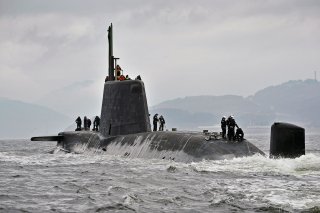Why the Might Royal Navy Wants to Build a Submarine Mothership
Now it seems the Royal Navy has been looking ahead to potential threats it may face in the mid-21st century and beyond.
Fittingly known as the "Senior Service," the Royal Navy was founded 475 years ago, and it remains the oldest of the UK's armed services.
Following the end of the Cold War, the Royal Navy began to experience a gradual but still significant decrease in its fleet size.
However, the debate of the size of the Royal Navy has been questioned repeatedly in recent years with a 2013 report finding that the UK would have to depend on her allies were overseas territories to be attacked. The total number of ships and submarines has continued to reduce, even as newer and more capable warships have been brought into service in the Queen Elizabeth-class aircraft carriers, Astute-class submarines, and Type 45 destroyers.
Now it seems the Royal Navy has been looking ahead to potential threats it may face in the mid-21st century and beyond.
Naval-Technology has reported that the British government had detailed the challenges in the "Under Water Battlespace" in a presentation from December 2020. One of the slides described the so-called "Atlantis 2040," which noted, "Our vision for the underwater domain is ambitious, we must leverage cutting edge technologies from industry, academia and the RN [Royal Navy] innovation ecosystem, through operational experimentation, deployed alongside our conventional RN platforms to accelerate and de-risk future capabilities."
The concept for 2040 called for the adoption of a semi-autonomous "mothership" submarine that would be capable of deploying unmanned underwater vessels (UUVs), or naval drones, that could operate in otherwise inaccessible areas. The slide deck suggested that the autonomous vehicles could provide remote sensing, anti-warfare (ASW) barrier and area denial capabilities. Additionally, extra-large UUVs (XLUUVs) would provide even longer-range underwater operations.
Naval-Technology also noted that another slide read, "Atlantis is our vision for a hybrid underwater capability in 2040. Centered on a semi-autonomous next-generation submarine, operating in concert with remote, autonomous, and uncrewed platforms, in a networked and digitized battlespace, delivering effect above and below the surface."
The submarine mothership, which could launch underwater "Precision Strike Missiles," would also work in concert with small unmanned aerial vehicles (UAVs) and a field of sonobuoys to detect enemy submarines. It would all be part of a greater effort to do more with less – or at least fewer human sailors and fewer large warships.
A variety of autonomous vehicles – both aerial and underwater – would create a "networked battlespace," which would be used to relay information back to the mothership, while autonomous mine-hunting vessels could neutralize mine threats.
The Royal Navy is not alone in developing UUVs that could be employed from a larger mothership. The United States Navy has been working on its own platforms, and recently it was announced that DARPA, the United States Department of Defense's research agency, has selected three companies for the Manta Ray project, which aims to develop a long-range unmanned underwater vehicle (UUV) that can operate without for extended periods without a need to return to port for maintenance and resupply.
Technology will certainly change the way wars could be fought under the sea.
Peter Suciu is a Michigan-based writer who has contributed to more than four dozen magazines, newspapers and websites. He regularly writes about military small arms, and is the author of several books on military headgear including A Gallery of Military Headdress, which is available on Amazon.com.

